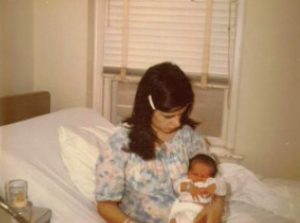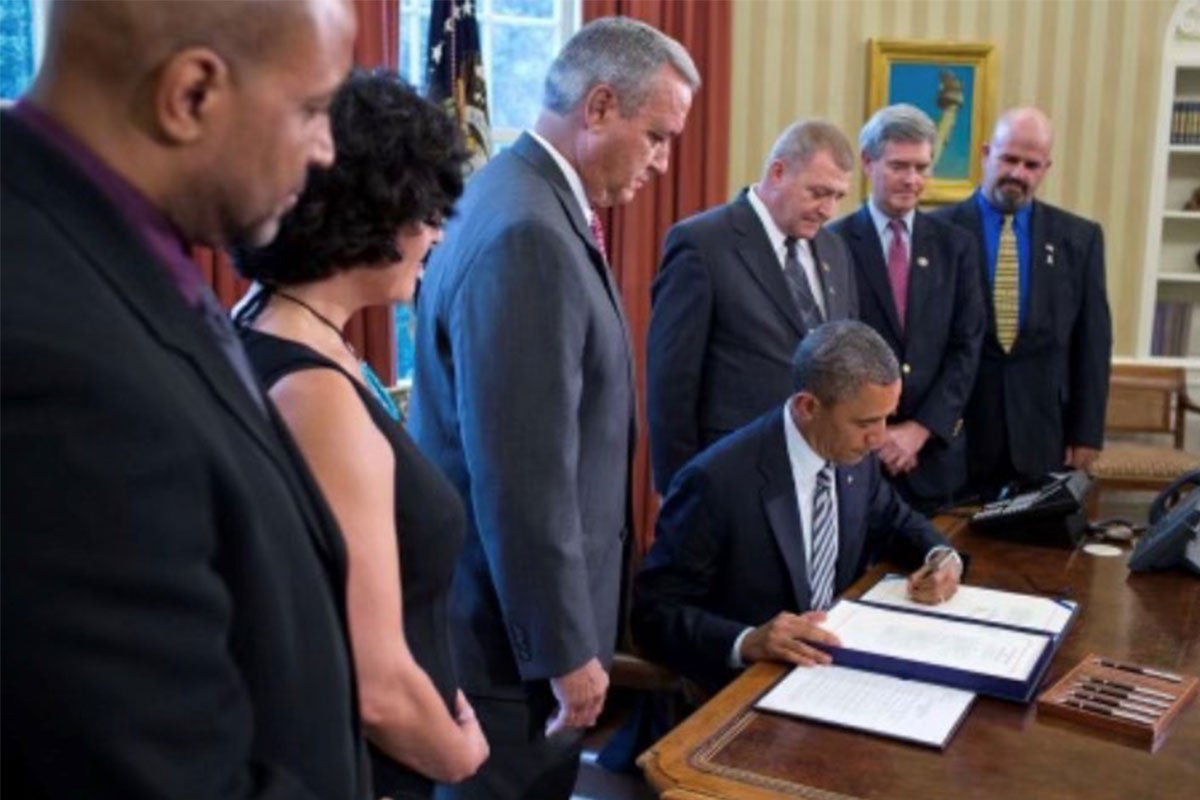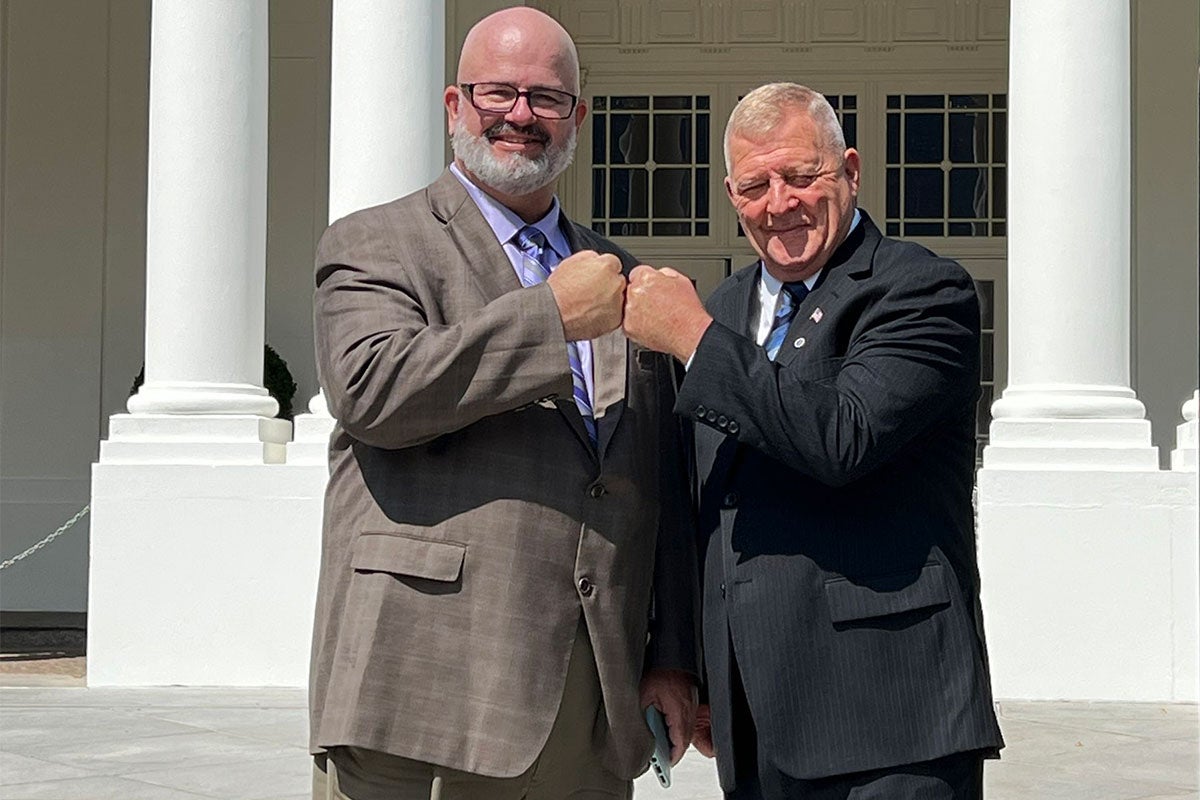When Mike Partain ’21MA was 39 years old, his wife hugged him and felt a lump in his chest.
The lump didn’t go away, so Partain scheduled a doctor’s appointment. To his surprise, the doctor referred him for a mammogram.
“I remember sitting in the waiting room, and they left me there for a while, thinking I was waiting for my wife,” Partain says. “I get back [to the exam room], and they give me a pink smock with flowers on it. The nurse came in, and I looked at her and just knew something wasn’t right. I could tell from the expression on her face.”
“The nurse came in, and I looked at her and just knew something wasn’t right. I could tell from the expression on her face.”
Partain met with a radiologist, who referred him to a surgeon for a biopsy. Two days later, Partain learned that he had male breast cancer. He underwent a right radical mastectomy to remove the 2 1/2-centimeter tumor.
“The hospital said my risk of getting male breast cancer in the general population at my age was .005%,” says Partain.
“Male breast cancer typically affects men who are 70 or older, who have the BRCA1 or 2 hereditary breast cancer markers — I don’t have those — or who are of European Jewish descent, which I’m not. I don’t drink. I don’t smoke. So, the whole time I’m wondering: ‘What contest in hell did I win to get breast cancer?’ ” he says.
The Truth About Camp Lejeune
A few weeks later, as Partain was preparing for chemotherapy, the phone rang. His father, a retired Marine and Vietnam veteran, urged him to turn on CNN.
“Up to that point, ‘Camp Lejeune’ meant nothing more than some words on my birth certificate,” recalls Partain. “It’s a Marine Corps base in Jacksonville, North Carolina. I was born there on January 30, 1968.”
That all changed as Partain watched retired Marine Master Sgt. Jerry Ensminger testify before Congress on CNN.
Ensminger spoke about his daughter Janey, who was conceived at Camp Lejeune and died of leukemia at age 9. He testified that children of Marines born at Camp Lejeune between January 1968 and December 1985 may have been exposed to toxic chemicals in the base’s drinking water, including tetrachloroethylene, trichloroethylene, vinyl chloride and benzene.
“That’s the first time I had heard about Camp Lejeune, the first time that I realized that something bad had happened, and also the first time I realized why I had breast cancer.”
“I about passed out,” says Partain. “That’s the first time I had heard about Camp Lejeune, the first time that I realized that something bad had happened, and also the first time I realized why I had breast cancer.”
Camp Lejeune, the largest Marine base on the East Coast, was established in 1942 to help train U.S. Marines for the beach landings that would be instrumental to winning World War II. Unfortunately, the Navy engineers who designed the base drew its water from a shallow aquifer that was polluted over several decades by leaking underground storage tanks, spills, drum disposal, and contaminants seeping into the ground from on-base units that cleaned military equipment.
Three separate water distribution systems that historically supplied water to the majority of the base’s family housing units were eventually found to be contaminated with volatile organic compounds. Tetrachloroethylene and trichloroethylene, both carcinogens, were 20 and 280 times over acceptable levels, respectively.
It is estimated that as many as 1 million people were exposed to the contaminated water at Camp Lejeune, making it one of the worst examples of water contamination in U.S. history.

Marines, their families, and civilian employees have been affected by kidney cancer, bladder cancer, leukemia, Parkinson’s disease, non-Hodgkin’s lymphoma, miscarriages, and birth defects.
“I was conceived, carried, and delivered on the base,” says Partain. “So, the most important time of my life — from the moment I was conceived to the moment I was born — my mother was drinking the water, bathing in the water; she was ingesting these chemicals and then passing them to the fetus. My exposure happened at probably the most vulnerable time in my life, and it’s done damage that lasted my entire life.”
Partain’s Advocacy
Learning the truth about Camp Lejeune quickly set Partain on a path of advocacy that has lasted for 15 years.
“My background is in history,” Partain explains. “I used to be a history teacher in the International Baccalaureate program at Bartow High School. So, it was up my alley to investigate and start reading about what happened.”
“My background is in history. … So, it was up my alley to investigate and start reading about what happened.”
Ensminger invited Partain to join a community assistance panel, which was meeting with the government about the contamination at Camp Lejeune. He began reaching out to the media, tracking down others impacted by Camp Lejeune’s toxic water, assisting the government in health studies and combing through relevant documents.
In 2009 and 2010, Partain testified before Congress as an expert on the history of Camp Lejeune. Since 2007, he has located 125 men who were exposed to the toxic water on base and had male breast cancer, the largest male breast cancer cluster ever identified.
“I started [working with Ensminger] by organizing thousands of documents, several thousand pages of documents, and I constructed a 44-page community narrative that we called a ‘timeline of events,’ ” says Partain. “I looked at the documents, and I looked at what the Marines said happened, and I realized that the two didn’t really match.”
Partain’s timeline of events helped shift the narrative away from what the Marine Corps claimed happened at Camp Lejeune to the reality that the community had discovered.
It became clear that Camp Lejeune did not follow the Navy’s potable water instructions. When water regulation testing requirements were tightened in 1972, the Marine Corps did not adhere to the new standards. And by 1980, independent labs began warning the base that the water was contaminated. At this point, in Partain’s opinion, the Marine Corps was guilty of criminal negligence.
“When we were done, there’s pretty much been an acceptance in Congress and the media that the base was contaminated, the water was contaminated, and for seven years they knowingly poisoned their own people,” says Partain.
In 2009, as a result of the community’s research, the Agency for Toxic Substances and Disease Registry revised its 1997 public health assessment of the drinking water at Camp Lejeune. It was the first time in the agency’s history that they had ever withdrawn or corrected a public health assessment.

Three years later, President Barack Obama signed the Honoring America’s Veterans and Caring for Camp Lejeune Families Act of 2012, which included the Janey Ensminger Act. It granted healthcare on a limited basis to servicemembers and their families who were based at Camp Lejeune during the period of water contamination.
Although the passage of the act represented a victory for advocates like Partain, he and others who were treated before its passage were not eligible to retroactively claim medical expenses.
Preserving the Research
In 2013, Partain enrolled at UCF part-time to pursue his master’s degree in history, balancing college coursework with a full-time job and his continued advocacy.
“My master’s thesis focused on our work with Camp Lejeune,” says Partain. “I used the timeline and the narrative to illustrate what we did as a social justice movement, the steps we took to get control over the narrative about what happened. Having this memorialized — how we did what we did — will help other communities facing similar situations.”
His third daughter is now set to start her junior year at UCF.
“UCF is a great school,” Partain says. “It’s a beautiful campus, and I really enjoyed the experience. I was 40-something years old, and I got to be a college student again.”
A Final Victory: The PACT Act
Despite significant progress over the years, Partain and other Camp Lejeune advocates encountered a setback in 2014.
An electronics company in North Carolina was sued by nearby property owners for pollution that turned up in their wells in 2009, 24 years after the company’s plant had shut down. The Supreme Court ruled in favor of the electronics company, upholding North Carolina’s “statute of repose,” which says that a company cannot face damage claims more than 10 years after its last act of pollution.
“Basically, this meant that I would have needed to have a suit against the government 12 years before I knew I had cancer to prove that I was poisoned at Camp Lejeune,” says Partain. “We’ve been trying to get that case reversed for the past eight years.”
On Aug. 3, 2022, this goal was finally achieved through the passage of the PACT Act, which contains the Camp Lejeune Justice Act. The act will provide healthcare benefits to members of the military exposed to toxins while serving, and it will allow Marines, their families, and civilian workers who suffered water toxicity-related diseases to seek compensation from the government.
“This bill represents justice. … It restores our rights.”
“This bill represents justice,” says Partain. “We’re not asking for a free hand-out. My breast cancer was caused by the water. I want a jury of my peers to review my arguments, and the government’s [argument] for that matter, and decide whether or not I was harmed. And the bill gives us that. It restores our rights.”
Partain was present for both the passage and the signing of the PACT Act.
“I sat there watching every move, listening to every conversation on the floor,” he says. “When the final vote was taken, many of the veterans wept and hugged one another as we realized it would pass. We were a part of history, a day I thought would never happen.
“History is not just a passive discipline. It is active and living and can help guide us to accomplish good in the world.”





